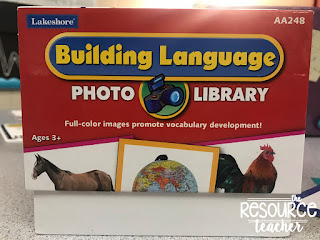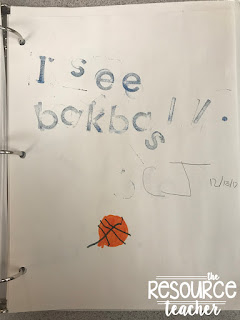Connect Four: So...the concept of this game is far beyond where my students are and quite frankly isn't really something I think my students need to learn how to play. So, I changed it up. I attached core vocabulary words to a file folder and taped it to the back of the game board/stand. Each student is given a color and when it is their turn they can select one word using their communication device and put their colored piece in that column OR they can start to build a sentence and put their colored piece in multiple spots. The person with the most colors at the end of the game wins. If a particular column gets filled up the students have to think of a different phrase.
This would be 2 colored pieces in the board.
This would be 1 colored piece in the board.
Sequence Letters: I honestly don't even know the rules of this game but my students just flip over a card and work together to find something that starts with that letter. If they are struggling the adult will narrow down a section of the board for them to look at.
Scrabble Junior: The students do really enjoy this game. We pretty much play the way it is intended to play except every time they match a letter they get to move their little game piece (verses when they complete an entire word).
Guess Who: You can easily adapt this to be anything you want. You can add letters to each of the flip down pieces and have students draw a card with a picture. If the picture matches a letter they have flip it down. You could say a letter sound and they can flip down that letter. You could add core vocabulary pictures and have them draw the words and see if they can flip down the correct picture. If you wanted to be more content driven you could put vocabulary words and have the students draw the definitions.
Physical Adaptions: Add velcro to the game board and pieces so students cannot easily knock them over. Color code the game to make it easier to see. Print out pictures of the students and have them make their own game pieces that way they are not having to remember the game rules and which piece is theirs.
Honestly the possibilities are endless. If you have an idea/concept you can easily adapt a game. Don't let the directions on the box limit you. I buy games for $5-10 all of the time and never think about how the actual game is played. I immediately think about how I can change it up to fit our needs. Games keep kids engaged, makes learning fun and allows you the opportunity to work on sooo many different skills.
Do you play games in your classroom? Have you considered adapting them?
 Follow my blog with Bloglovin
Follow my blog with Bloglovin

































